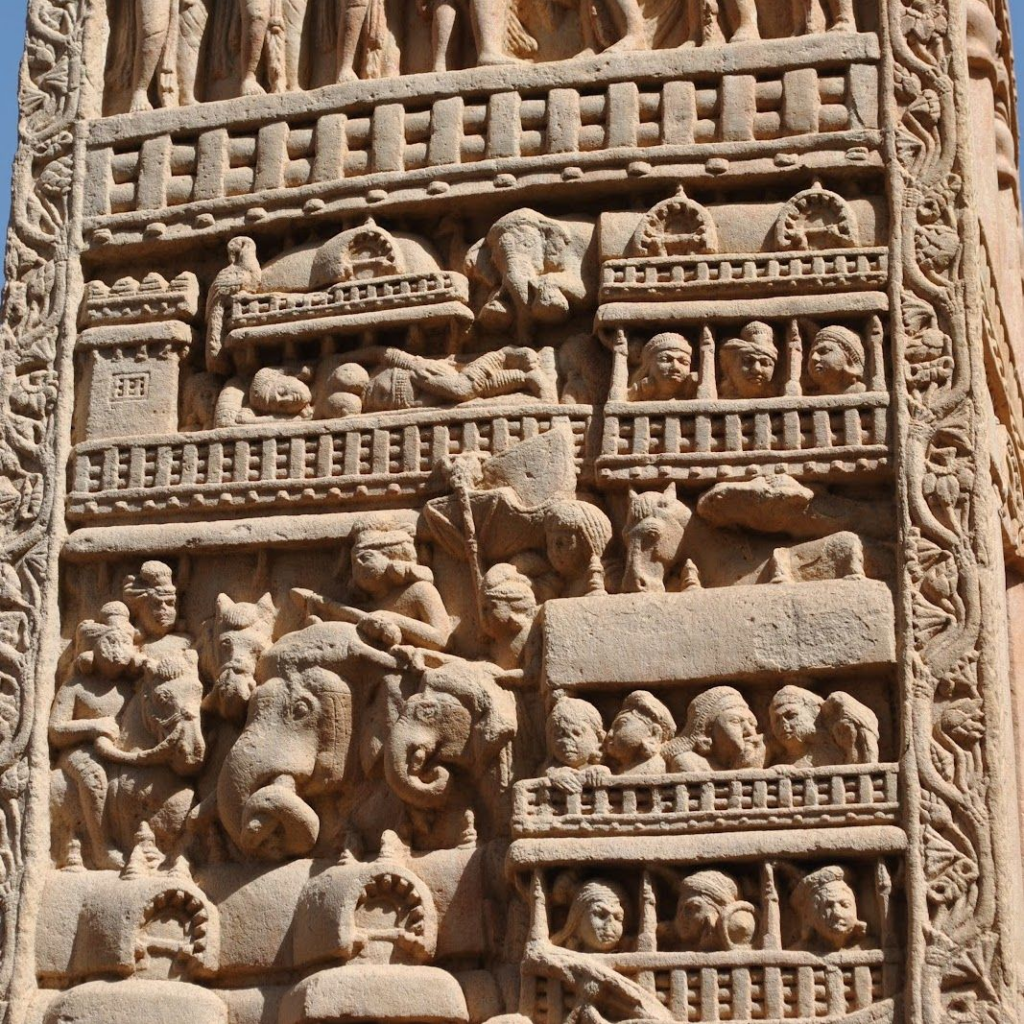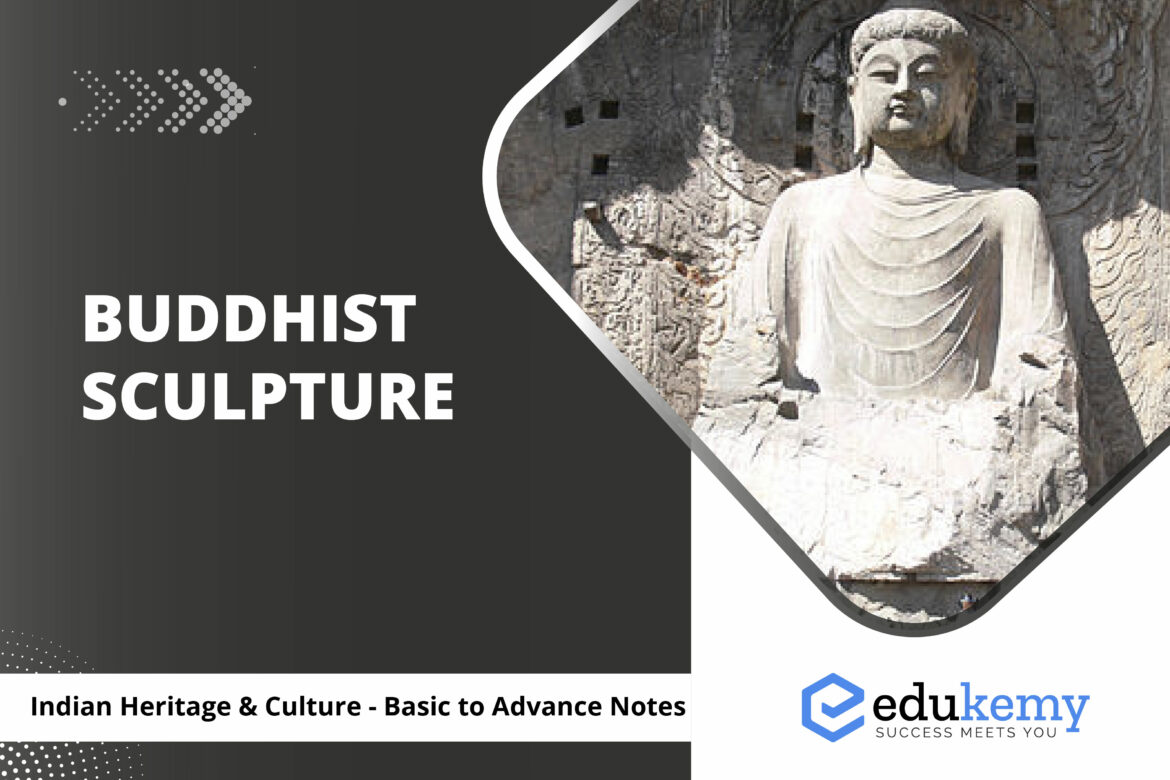
Buddhist sculpture stands as a profound expression of spiritual devotion and artistic mastery, reflecting the rich cultural heritage of Buddhism. Originating in the 1st century BCE, Buddhist sculptures have evolved across diverse regions, from the intricately carved reliefs of the Gandhara school to the serene stone statues of Southeast Asia. These sculptures often depict the Buddha in various mudras or postures, conveying specific teachings and aspects of enlightenment. The Gupta period in India witnessed a golden age of Buddhist art, with the creation of iconic sculptures like the Sarnath Buddha. Intricately crafted, these sculptures serve not only as religious symbols but also as conduits for meditation and introspection. The fusion of local artistic traditions with Buddhist philosophy has resulted in a vast array of styles, exemplifying the adaptability and universality of Buddhist teachings. The study of Buddhist sculpture not only unveils the artistic achievements of ancient civilizations but also provides insights into the spread and assimilation of Buddhism across Asia, making it a crucial area of exploration for UPSC aspirants.
From the second century BCE onwards, various rulers established their control over the vast Mauryan Empire: the Shungas, Kanvas, Kushanas, and Guptas in the north and parts of central India; the Satavahanas, Ikshavaku, Abhiras, Vakatakas in southern and western India. Incidentally, the period of the second century BCE also marked the rise of the main Brahmanical sects such as the Vaishnavas and the Saivas.
Some of the prominent examples of the finest sculpture are found at Vidisha, Bharhut (MP), Bodhgaya (Bihar), Jaggayyapeta (Andhra Pradesh), Mathura (UP), Khandagiri-Udaigiri (Odisha), etc.
Contents
- 1 Bharhut Sculptures
- 2 Sanchi Sculptures
- 3 Gandhara School of Sculpture
- 4 Mathura School of Sculpture
- 5 Amaravati School of Sculpture
- 6 FAQs
- 6.1 FAQ 1: What is a Buddhist mandala in art?
- 6.2 FAQ 2: What is the significance of a Buddhist mandala?
- 6.3 FAQ 3: How does Buddhist sculpture play a role in UPSC exams?
- 6.4 FAQ 4: What are the key features of Buddhist sculpture in India?
- 6.5 FAQ 5: Can you provide an example of a famous Buddhist sculpture in India that might appear in UPSC exams?
- 6.6 For Admissions, talk to our Mentor – 9811333901, 9811333782
Bharhut Sculptures
Sculptures of the Mauryan period, like the images of Yaksha and Yakshini, were tall. In relief panels depicting narratives, sculptors created an illusion of three-dimensionality with a tilted perspective. At Bharhut, narrative panels featured fewer characters, but as time progressed, additional characters appeared in the picture space besides the main character of the story. Sculptors maximized the use of space, creating flat images of folded hands in narratives and single figures of Yakshas and Yakshinis clinging to the chest.
Initially, there was a general stiffness in the body and arms of sculptures. However, over time, visual appearance was modified by creating images with deep carvings, pronounced volume, and a naturalistic representation of human and animal bodies. Good examples of these can be found in sculptures at Bharhut, Bodhgaya, Sanchi Stupa-2, and Jagayyapetta. Narrative reliefs at Bharhut effectively communicate stories using pictorial language. For instance, in one narrative, Queen Mayadevi’s (the mother of Siddhartha Gautama) dream is depicted with a descending elephant.
One characteristic common to all male images of the second century BCE in Bharhut sculptures is the knotted headgear.

Sanchi Sculptures
- Stylistic Progression in Sculptural Development at Sanchi Stupa-1, Mathura, and Vengi.
- Four beautifully decorated toranas depicting various events from the life of the Buddha and the Jataka are present, as well as depictions of normal life.
- The figure compositions are in high relief, filling up the entire space, and the depiction of posture becomes more naturalistic, with reduced stiffness in the body.
- The heads have considerable projection in the picture space, and the rigidity in the contours is reduced, giving image movement.
- The carving techniques are more advanced than those at Bharhut, and symbols continue to be used to represent the Buddha and the Manushi Buddhas or the past Buddhas.
- Historical narratives, such as the siege of Kushinara, Buddha’s visit to Kapilavastu, and Ashoka’s visit to the Ramgrama Stupa, are carved with considerable details.

Gandhara School of Sculpture
- The sculptures of Gandhara were influenced by Bactria, Parthia, and local traditions.
- Gandhara sculpture flourished during the Kushan dynasty in the North-West frontier of India.
- Grey/bluish-grey sandstone was used for creating these sculptures.
- Buddhism served as the main inspiration behind many of these sculptures.
- The depiction of Buddha in Gandhara sculpture exhibits a sense of calmness.
- Buddha is shown with fewer ornaments and wavy hair.
- Buddha’s large forehead and closed eyes are common features in Gandhara sculpture.
- The seated Buddha is always shown cross-legged in the traditional Indian way.
- Buddha and Bodhisattva figures resemble the Greek God Apollo, with broad shoulders and a halo around the head.
- The physical features of the sculptures, such as muscles, nails, and hair, are depicted with great detail.

Mathura School of Sculpture
- Spotted sandstone was the preferred medium for sculptures in Mathura.
- Mathura’s style of sculpture was influenced by outside traditions, including the Mathura school of sculptures.
- Jainism, Buddhism, and Hinduism were depicted in Mathura style.
- Kushana rulers were patrons of this school of sculpture.
- Salient features of this school of sculpture include:
- Buddha’s image is modeled after Yaksha’s images, unlike the Hellenistic features seen in Gandhara.
- Vishnu and Shiva are represented by their ayudhas.
- Bold carving, with volume projected out of the picture plane.
- Round, smiling faces with relaxed flesh.
- Garments cover the left shoulder.
- Buddha, Yakshas, Yakshinis, Shaivite, and Vaishnavite deities, and portrait statues are profusely sculpted.
- In the second century CE, images became more sensual and fleshier.
- In the third century CE, sculptural volume changed with reduced fleshiness and increased movement in posture.
- Softness in the surface continues to get refined.
- Transparent quality in Buddha image robes and profusely decorated halos.
Amaravati School of Sculpture
- A Buddhist relic belonging to Amaravati School of Art was discovered on the banks of River Gundlakamma in Andhra Pradesh by a group of Indologists.
- Amaravati art originated in the region of Amaravati, AP, and was patronized by the Satavahanas and later by the Ikshavaku.
- Amaravati, Nagarjunikonda, Goli, Ghantasala, and Vengi were prominent places where this style developed.
- The material used in Amaravati art is white marble.
- Sculptures were carved in a naturalistic manner, such as the “taming of an elephant by the Buddha.”
- The art reflects narrative themes based on the life of Buddha and Jataka stories.
- Buddha is depicted both in human as well as animal form.
- Both religious and secular images were present in this style.
- The Amaravati style is more elegant and sophisticated.
- The sculptured panels of Amaravati are characterized by delicacy of forms and linear grace.
- Numerous scenes of dance and music adorn these reliefs, displaying the joy of life.
FAQs
FAQ 1: What is a Buddhist mandala in art?
Answer: A Buddhist mandala is a geometric, intricate design that serves as a spiritual symbol and a tool for meditation in Buddhist art. It often features a central deity or concept surrounded by various symbolic elements. Mandalas are used in various Buddhist traditions to aid in visualization and concentration practices.
FAQ 2: What is the significance of a Buddhist mandala?
Answer: Buddhist mandalas have several layers of significance. They symbolize the universe, unity, and wholeness. They are used as a means to guide individuals towards enlightenment and represent the journey from the outer material world to the inner spiritual realms. Mandalas also serve as aids in rituals and meditation.
FAQ 3: How does Buddhist sculpture play a role in UPSC exams?
Answer: In the UPSC exams, especially in the Art and Culture section, candidates are often asked about the significance and characteristics of various forms of art, including Buddhist sculpture. Understanding Buddhist sculpture is important to answer questions related to the art and culture of ancient India, as well as to grasp the cultural heritage of the region.
FAQ 4: What are the key features of Buddhist sculpture in India?
Answer: Buddhist sculptures in India are characterized by serene expressions, intricate details, and the use of various materials such as stone, bronze, and stucco. Common themes include depictions of the Buddha, Bodhisattvas, and various symbols like the Dharma wheel. The art often reflects the evolution of Buddhist beliefs and the impact of different dynasties on the style.
FAQ 5: Can you provide an example of a famous Buddhist sculpture in India that might appear in UPSC exams?
Answer: The Great Sanchi Stupa is a notable example of Buddhist sculpture in India. This stupa, located in Sanchi, Madhya Pradesh, features intricate carvings and sculptures that depict various aspects of the life and teachings of the Buddha. It’s considered a masterpiece of Indian Buddhist art and is a significant topic for the UPSC exam’s Art and Culture section.
For UPSC Prelims Resources, Click here
For Daily Updates and Study Material:
Join our Telegram Channel – Edukemy for IAS
- 1. Learn through Videos – here
- 2. Be Exam Ready by Practicing Daily MCQs – here
- 3. Daily Newsletter – Get all your Current Affairs Covered – here
- 4. Mains Answer Writing Practice – here
Visit our YouTube Channel – here

